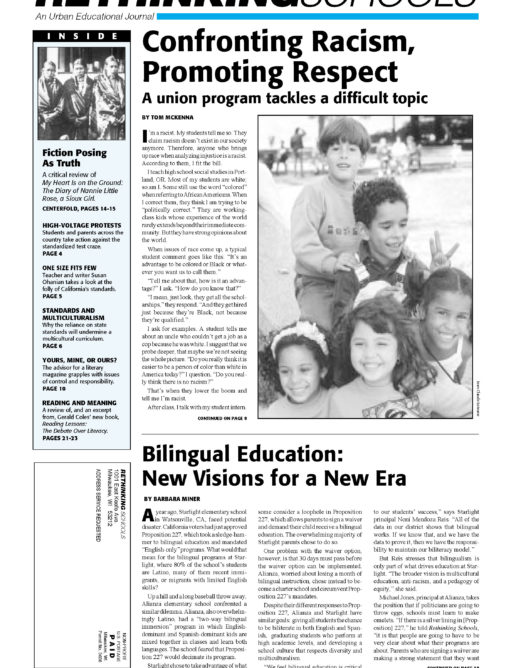To Improve Bilingual Ed…
Rethinking Schools asked a number of people involved in bilingual education about the challenges facing bilingual programs. Following are excerpts from their answers.
Josue Gonzalez, director of the Center for Bilingual Education and Research at Arizona State University.
I refuse to answer the question, Does bilingual education work? Bilingual education is like monolingual education. Sometimes it works, sometimes it doesn’t. It all depends on how well you do it.
It’s important to be clear about the vision [for bilingual education], and that vision has to do with biliteracy, not emptying out the Spanish in order to make room for English.
The vision of biliteracy has to be open to everyone, not just language minority kids, and it should focus on Spanish. Spanish is the number one language in the hemisphere and the number two language in the country.
Rosita Apodaca, assistant superintendent in San Francisco who oversees bilingual education.
We have to ensure that regardless of the type of program, a two-way, a one-way, an early- or a late-exit, we have to have a quality program. Defining quality is essential, which is why San Francisco has developed 10 “Academic Master Principles” as minimum indicators of quality.
Parents want accountability. I don’t care if they are a language majority or a language minority. Our 10 indicators define the accountability.
The challenge is always professional development, but not in a way that penalizes a teacher. When corporations approach professional development, they don’t ask their staff to use their vacation, or their Saturdays or evenings, in order to get the training. It has to be the same with teachers. Furthermore, it must be sustained and deep professional development, not one-shot deals.
Parent involvement is key. We have not engaged our parents. We have talked to our parents, we have asked them to come to meetings, but we have not really made them partners in the education of their children. In San Francisco, we are seeing the benefits of such engagement.
Tony Baez, bilingual activist currently at the Milwaukee Area Technical College.
In general, bilingual reform is treated as something separate rather than a component of any number of good education reforms. Bilingual education, by and large, is not part of the discourse of the new breed of progressive reformers.
One of the big challenges is multiculturalism. We have abandoned the multicultural discourse for fear of being labeled “ethnic proponents.”
We ought to involve the communities who speak more than one language and bring them into the reform process in a more meaningful way. Right now, the reforms by and large are being conceptualized in isolation from this sector of the community.
Steven Pollard, third-grade bilingual teacher in Irving, TX.
I have talented, very intelligent children in my classroom who, it just so happens, don’t learn best in English. Since bilingual education is viewed as an inferior program, there is a push to exit children too rapidly from the program. This hurts the child and the program.
A lack of consistency in the programs has damaged the effectiveness of bilingual education. This is all as a result of the basic ignorance that administrators and the public have of the second-language acquisition process.
We need better trained teachers at the university level. Too many ill-prepared teachers are in bilingual classrooms.
Richard Ruiz. head of the Department of Language, Reading and Culture at the University of Arizona.
The greatest promoters of bilingual education also tend to be the greatest critics — of the remedial aspects, the issues of segregation, lack of qualified teachers, funding issues, commitment on the part of the administration, thinking through what it means to teach bilingually. Most people criticize bilingual education not because it is bilingual, but because it is not bilingual enough. But when you are in a fight so publicly political as this one is, you are reluctant to say anything negative because it will be used by the opponents of bilingual education to trash it completely.
One of the major concerns is that of language proficiency in both languages. What happens sometimes is you get a teacher who is extremely good in the first language of the child, but not very proficient in English. Or the other way around — an English-dominant teacher who learned some Spanish in school but doesn’t know it very well.
Jim Cummins, from the University of Toronto, who has written extensively on bilingual education.
One of the problems is that in some bilingual programs, there hasn’t been a strong enough pedagogical vision. Bilingual education has been seen as a panacea, that all we need to do to resolve problems of underachievement is provide some first language instruction and everything else will take care of itself.
Stephen Krashen, from the University of Southern California, who has extensively studied how students learn a second language.
We must vastly improve the print environment in our bilingual programs. Reading for meaning, especially voluntary reading, is the major source of literacy competence. Yet one study of libraries in schools with bilingual programs found there was, on average, only one book in Spanish for each Spanish-speaking child.

